Claussen Pickles are kosher dill pickles at their crunchiest, saltiest best! These homemade Claussen pickles taste like the commercial ones you find at the store, but better. And better yet, they’re ridiculously easy to make!
Whether you’re new to pickle making or a pickle veteran, you NEED to make these half sour pickles! And wonder of wonders, you don’t need to know how to can to make these super fresh, crunchy pickles! Claussen dill pickles are meant to be eaten fresh.
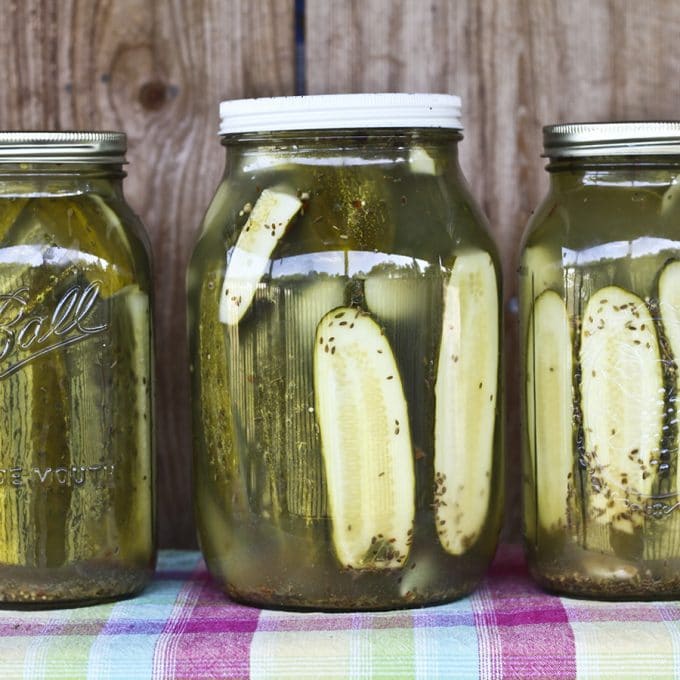
Homemade Claussen Knock-Off Pickles: Always crunchy and garlicky, this perfect homemade pickle recipe requires no special equipment, & no canning experience.
It’s common knowledge that I have a salty tooth rather than a sweet tooth. When the weather does what it has been doing lately (making us all do our best Shadrach, Meshach and Abednego impersonations) I can’t think of a single thing I find more refreshing than an icy-cold, salty, crunchy pickle.
It’s not just me, it’s my whole family: mother, sisters, brothers, cousins, aunts, grandparents, kids, husband… I married a man who loves pickles so much he eats the pickles and then drinks the juice from the jar.
I grew up eating my Grandma’s homemade dill pickles like the supply was endless and moved on to canning my own pickles as soon as I had a kitchen of my own. There’s just something about a homemade dill pickle that makes me happier than any pickled cucumber ever should.
My little sister, Jessamine, and I compare our homemade pickles from year to year the way some people compare wine vintages.
Dill Pickle Recipe
But there is one pickle that stands head-and-shoulders (were pickles to *have* heads and shoulders) above all others. I’m talking about the pickles you see here. That’s right: Homemade Claussen Dill Pickles.
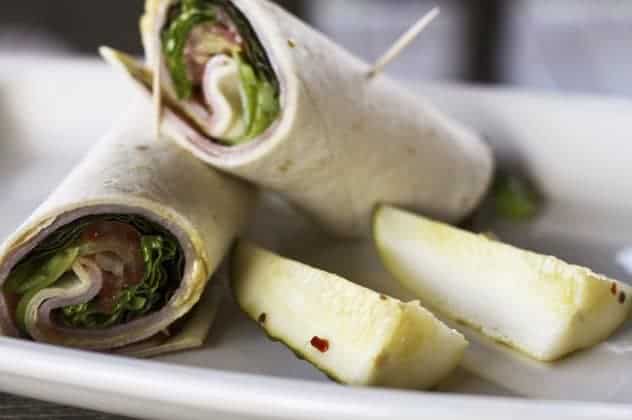
Recipe for Claussen Pickles
What do you need in order to make this recipe for Claussen Half Sour Pickles at home? Let’s get a quick list for both ingredients and equipment out of the way, shall we?
Equipment for Making Claussen Pickles at Home
- A Glass gallon jar or 4 glass quart jars or other food safe container with a tight fitting lid
- Measuring cup
- Chef’s knife or paring knife
Ingredients for Making Homemade Claussen Pickles Copycat
- Small to medium size pickling cucumbers (check your local farm stand or farmer’s market!)
- Apple Cider Vinegar (don’t fret- it doesn’t taste like apple cider and isn’t even a little sweet!) or white vinegar
- Kosher Salt
- Garlic
- Dill (either fresh or dill seed)
- Pickling spices (available here)
A quite note on your vinegar choice: I opt for apple cider vinegar because it’s a smoother vinegar than white vinegar. It does not impart any sweetness or apple taste to the pickles whatsoever.
If you can’t find it (pssst. It’s right next to white vinegar in even moderately stocked grocery stores) or don’t feel like buying it, you can most certainly substitute white vinegar. It’ll just taste a little sharper. (And technically store bought Claussen pickles have white vinegar, so you do you!)
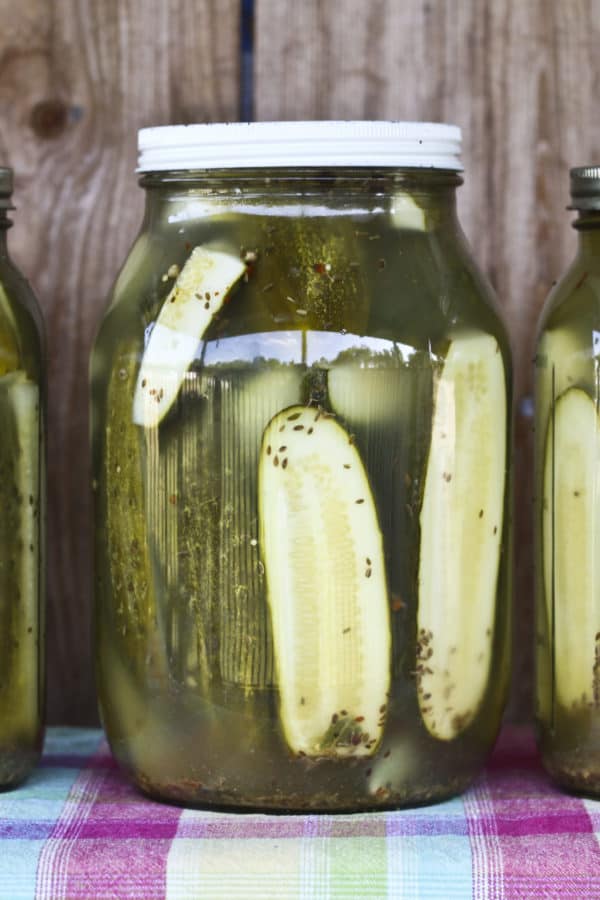
And ya’ll. These homemade half sour pickles are so easy to make it’s almost criminal.
The hardest part is the 2 to 4 day wait for them to be done. Truth be told, though, I’ve snacked on them the day after I made them and been a very happy camper.
Claussen Pickle Recipe
These are homemade refrigerated deli pickles, also known as Lithuanian half-sours, also known (in the commercial equivalent) as Claussen dill kosher pickles, also known as the best pickles ever known to mankind.
Here’s the thing. While I do love my other homemade pickles dearly (otherwise why would I continue canning ninety-something quarts year after year after year), these are by far my all-time favourites.
CRUNCH. That’s what you hear when you bite these. There is no flop, no squish, no soft pickles. These things almost bite back.
This also happens to be the perfect dill pickle recipe for beginning pickle makers. If you’re not into canning, these refrigerator pickles are a godsend. Even if you ARE canning obsessed, like yours truly, this Claussen pickle recipe should be in your pickle repertoire too.
Please note that this Claussen pickle recipe is not suitable for canning. The brine is fermented and not very acidic, which means it has far too high a PH to can safely. If you’re looking for a great canned dill pickle recipe, try this home canned garlic dill pickle recipe.
Refrigerator Pickles
Here’s where we get into the best part of this pickle recipe (aside from the crunch and flavor). You don’t have to cook anything to make these pickles; not one single thing. The brine is stirred together, the cucumbers are rinsed, trimmed and stuffed into a jar with garlic cloves and spices.
These half sour pickles are NOT CANNED. They are simply put into jars. Amen!
When it’s summer time and the idea of turning on the stove makes me want to crawl into an (air conditioned) hole, these pickles are a welcome treat. Not only is that cold crunchy refrigerator pickle waiting to cool me off at the end of the prep time, but I don’t have to heat up my kitchen by even one single degree to get there.
Remember that pickling isn’t just for cucumbers, either! Try out our Pickled Brussels Sprouts, Quick Pickled Red Onions, and famous Candied Jalapenos!
How to Make Pickles FAQ
Please, please, please give these a go even if you have never made a pickle before. There is nothing scary or intimidating here. Wash, slice, stuff, stir, pour, sit, wait.
- Trim 1/8-inch from the blossom end of each cucumber and slice them in half lengthwise or into quarters. The size you choose depends on how large your cucumbers are and how big you want the pickles to be when they’re done. This helps minimize the chances of soft pickles.
- In a gallon jar (or large, wide-mouth, food-safe container) layer the dill heads or seed, pickling spice or mustard seed, and garlic cloves and sliced cucumbers. If you’re dividing the cucumbers up between smaller containers, just divide the garlic and spices evenly between the containers, too.
- Stir your brine together in a separate container. You WILL have more brine than you have space for in the jars, but that’s why you pack the spices in the jars. Just store extra brine in a jar in the refrigerator and use it to top off your pickles if the brine starts evaporating.
- Pour the brine over the cucumbers, taking care to make sure all of them are fully submerged. If needed, place a plate or mug or other ziploc bagged can of beans on the cucumbers to weigh them down and keep them under the brine!
- Cover the jars lightly not tightly and leave out of direct sunlight on the counter for two to four days or until the pickles are picklicious.
- If your kitchen is pretty hot or humid, you can stash them directly in the refrigerator. They’ll just take a couple of days longer to get fabulous. Your patience will be rewarded.
On the plus side, the wait is only two to four days which is significantly less than the six week wait of the canned pickles. Besides, as I said, there is the crunch factor
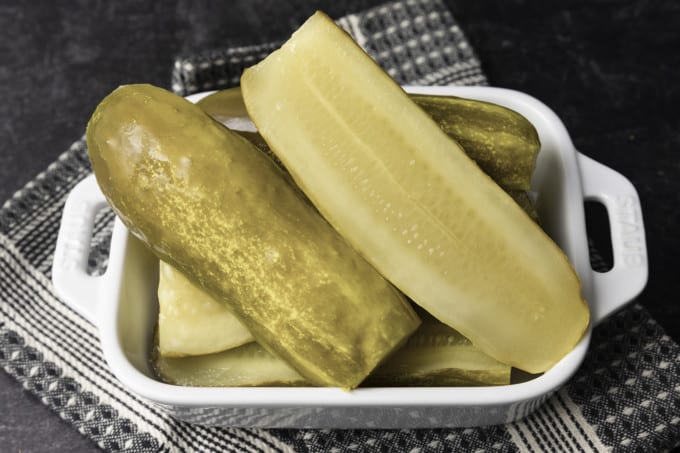
Troubleshooting Your Homemade Claussen Pickles
These pickles are easy peasy to make, but there still may be a couple of things that pop up from time to time that make you go “Hmmm…” In no particular order, here are some of the most commonly asked questions about them and some answers!
- Why is my pickle brine cloudy? Okay, I lied. This is the most common question and that’s because the brine becomes cloudy naturally as a consequence of fermentation (which is what’s happening here.) No worries.
It’s all natural. This half sour pickle recipe (more on this to come) is a fermented pickle recipe and that just happens.
Another possible cause of intense cloudiness or discolouration in your brine is using table salt. The iodine in table salt can also give off flavours to your pickles, so it’s best to stick with kosher salt or pickling salt for these bad boys! - Is the scum, foam, or film on top of my pickle brine dangerous? It’s that pesky (and delicious) fermentation again! This is another thing you don’t have to worry about.
Just scrape it off with a spoon, discard, and top off with a little of that extra brine you whipped up. (See the recipe card for details.) But do remove the scum or it could cause your pickles to go bad. - My pickles went soft! How do I prevent this? This particular tragedy could have two causes.
First, you may have failed to remove enough of the blossom end of the cucumber. There is a naturally occurring enzyme in the blossom end of cucumbers that causes pickles to break down and become soft if it is not removed. Next time, just slice more off.
Second, you may have started with less than spectacularly fresh cucumbers. An older cucumber has had longer for the aforementioned enzyme to kick in, and it has already started its work.
The best solution for this issue is to use cucumbers that have either been picked fresh that day or have been refrigerated steadily since very shortly after being picked a couple of days previously. - Why did my pickles go bad? See that second reason in the “why did my pickles go soft” bullet point? That’s one culprit.
Other potential causes of spoiled pickles are using unwashed cucumbers or fresh dill, old or decayed garlic, bad spices, lower-than-5%-acidity-vinegar, failing to remove the scum from the brine or to keep the pickles submerged in the brine, or storing your pickles in warmer conditions. When in doubt, stash them in the refrigerator! - Why is there mold on my pickles? First, you have my condolences. Second, it’s because your pickles didn’t stay submerged in the brine. That brine has enough salt and acid to prevent mold growth if the cucumbers stay under the surface.
If you’re having trouble finding something that fits in the jar to keep this from happening, try popping a can or two of tomato paste or canned beans in a zipper top bag and gently inserting that into the jar. It should weigh it down enough to do the job. - Should I worry about the white sediment in my jar? This is another one in the “don’t sweat it” category. There are two potential reasons and both are completely harmless.
It’s either a natural consequence of the fermentation or anti-caking agents in the salt. Neither harms the pickles or effects the flavour, so don’t worry! - Why is my garlic blue/green/purple? As long you inspect the garlic before it goes into your jars and it is fresh as a daisy, you have nothing to worry about. It could be the type of salt you used or it could be the variety of garlic. Some types of garlic have a natural propensity to change pretty colours in vinegar.
It also may mean that your pickles were exposed to light. When garlic is exposed to light, it starts producing chlorophyll which is green. It also may indicate that your garlic is more mature.
In that case it is caused by sulfur compounds that naturally occur in more mature garlic reacting with minute traces of copper in the vinegar., but as long as there are no other signs of spoilage (soft or squishy texture, funky smell, discoloured spots), you’re good to go.
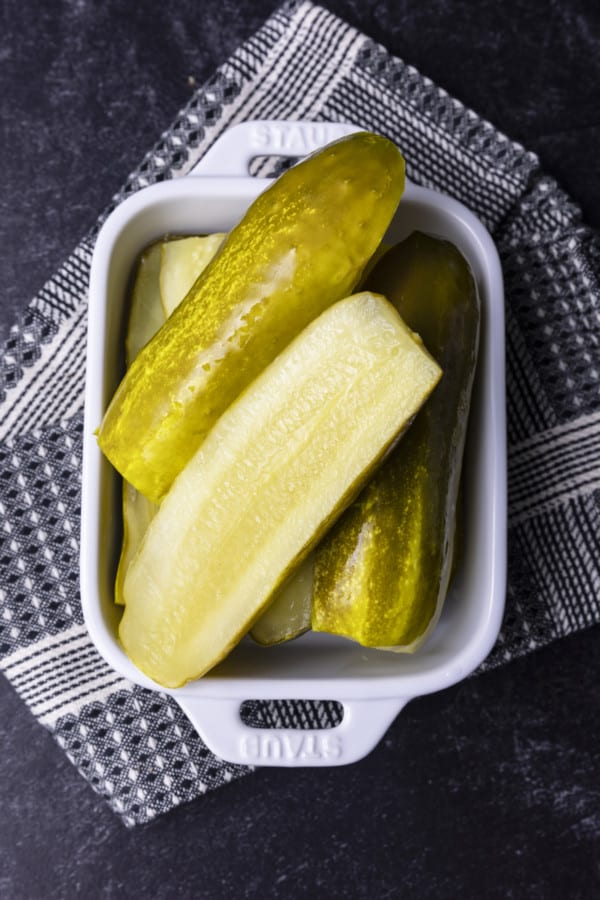
IMPORTANT NOTE: Because there is so much diversity in temperature, humidity, age of cucumbers, etc… involved in this recipe, please check your half sour pickles starting at 24 hours for doneness. If the pickles smell/taste pickley, move them to the refrigerator. Do not keep them on the counter longer than 4 days.
ANOTHER IMPORTANT NOTE: These pickles are not suitable for canning. They’re simply not acidic enough to can safely, and that is in addition to the fact that you’d ruin that perfectly crisp texture by introducing heat to the party.
What can I serve with these Homemade Claussen Knock-Off Pickles?
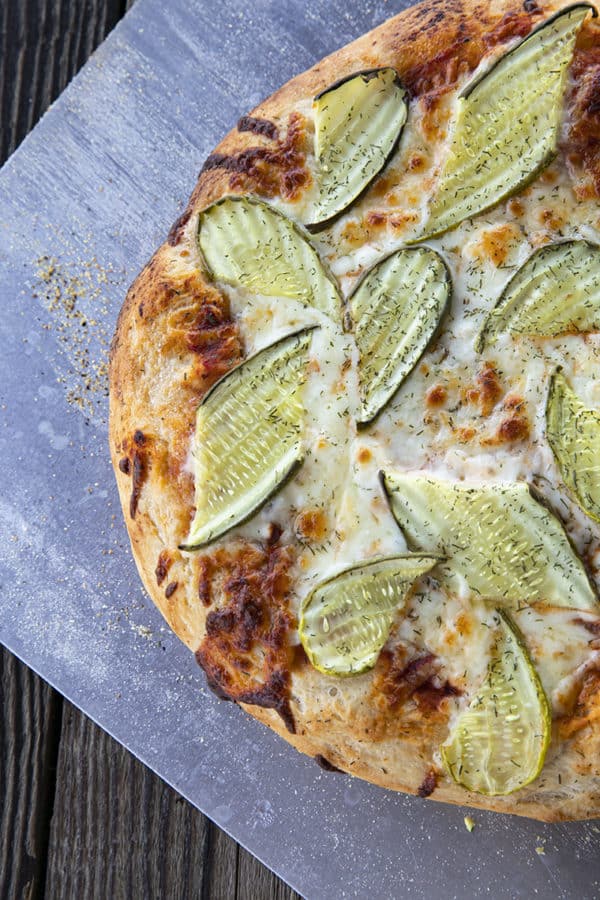
Start out by trying your half sour pickles in this Pickle de Gallo, Dill Pickle Dip, Dill Pickle Egg Salad, or Bagel Burgers with Dill Pickle Cream Cheese.
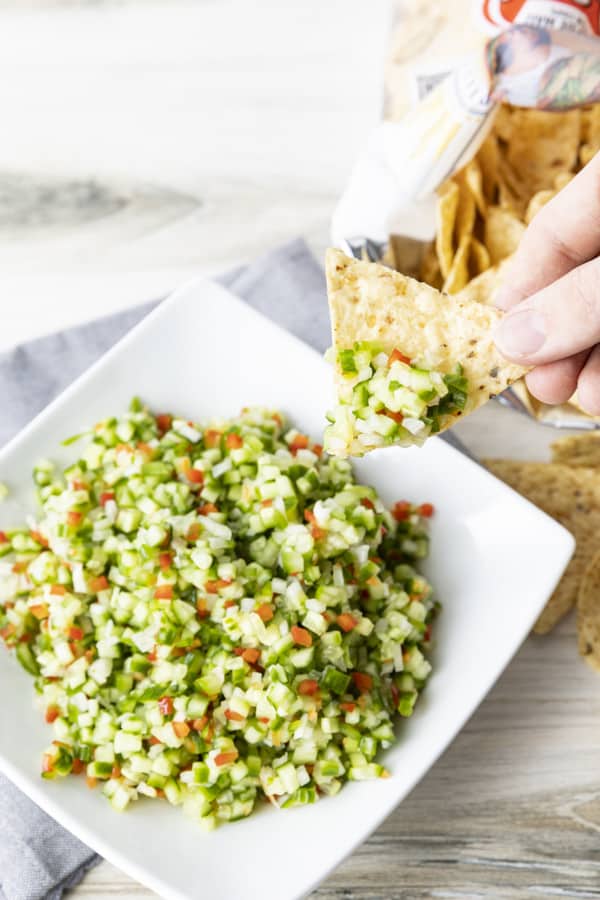
Even better, serve them on our Cheeseburger Salad or Pickle Pizza.
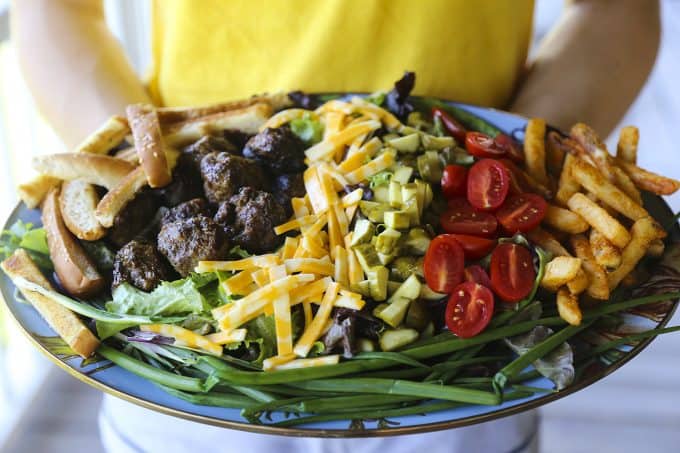
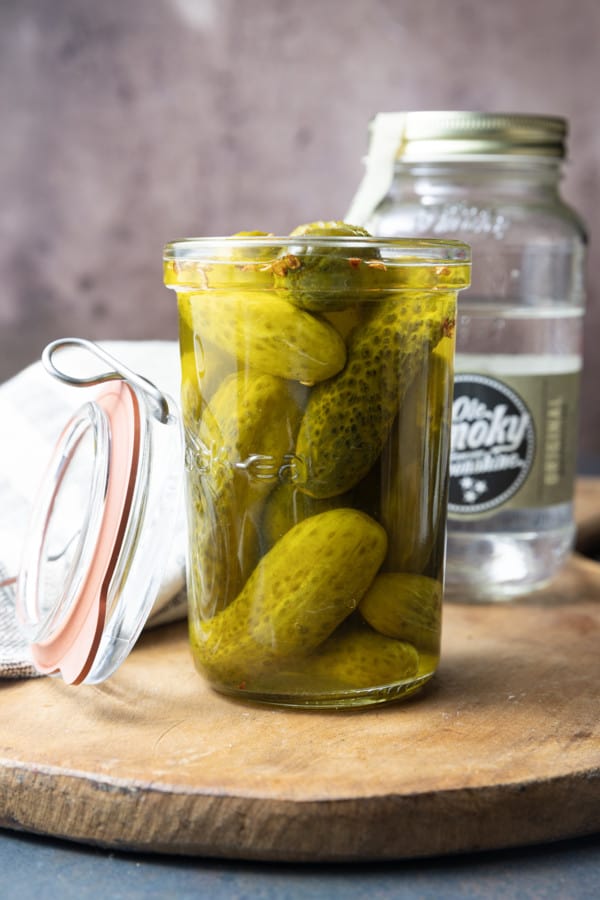
You can even take extra pickles (like that’s a thing!) and make these divine Moonshine Pickles. You’ve never had a better Bloody Mary than one made with homemade Moonshine Pickles!
Half Sour Pickle Recipe
What makes Claussen PIckles different from canned pickles? Claussen pickles, whether homemade or store bought, are a half sour pickle recipe.
That means they’re fermented instead of heat processed. That’s what gives them such great texture.
This half sour pickle recipe yields pickles that are crunchy to the point of making noise when you bite them, cold, and seriously garlicky. Canned, shelf-stable pickles can be chilled, maintain some crunch, and be as garlicky as you want them to be, but they are never, ever going to be the same thing because of science.
When you heat process a jar of pickles you are, in actuality, cooking it and a cooked pickle just plain can’t be as crunchy as an un-cooked half sour pickle recipe.
These homemade pickles keep well in the fridge for about six months, as long as they remain submerged in the brine. In our house, they never last that long because, as the saying goes, “A pickle a day keeps sad times away.”
They say that right? Someone must. If not, I’m going to start. It’s true, after all.
Claussen Pickles
Wash cucumbers but do not scrub them.
Trim 1/8-inch to 1/4-inch from the blossom end of each cucumber and slice in half lengthwise or into quarters, depending on how large your cucumbers are and how big you want them to be when they’re done.
Layer the dill heads or seed, garlic cloves, pickling spices and sliced cucumbers in a gallon jar (or large, wide-mouth, food-safe container). You can evenly divide the dill, garlic cloves, pickling spices, and cucumbers between several smaller jars if needed.
In a separate pitcher or bowl, stir together the remaining ingredients until the salt is dissolved.
Pour the brine over the cucumbers, taking care to make sure all of them are fully submerged. If needed, place a plate or mug or other non-reactive heavy item on the cucumbers to weigh them down and keep them under the brine!
Cover lightly with a lid just perched on top or secure a piece of cheesecloth over the jar with a rubber band to keep fruit flies away. Store any extra brine in a covered jar or pitcher in the refrigerator and use it to top off the brine if it starts to evaporate and expose the pickles to the air.
Leave out of direct sunlight on the counter for at least 24 hours, but up to 4 days, or until the cucumbers taste like pickles throughout.
Fix your lid onto your jar or container and chill thoroughly. These can be stored in the refrigerator for up to six months provided you keep them covered with brine.
NOTE: If at any point in the proceedings “fuzz” or “foam” develops on top of the brine, use a spoon to remove it. If there is “fuzz” attached to any of the cucumbers, remove the ones affected and be sure the others are still fully submerged.
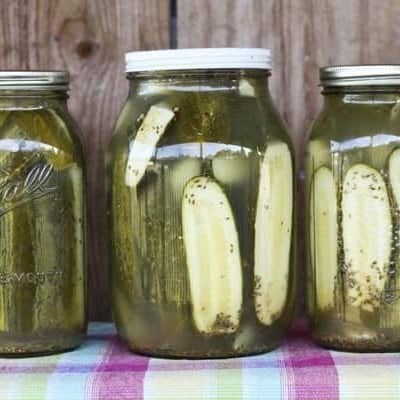
Homemade Claussen Knock-Off Pickles
Equipment
- 1 gallon jar or 4 quart jars or a large, food-safe container with a tight fitting lid
- 1 liquid measuring cup
- 1 large mixing bowl or pitcher
Ingredients
- 35 to 40 small to medium pickling cucumbers
- 1 gallon cold water
- 1 cup apple cider vinegar, preferably raw or white distilled vinegar
- 2/3 cup coarse canning or kosher salt Do NOT fine or use iodized salt!
- 4 cloves garlic or more to taste
- 4 heads fresh dill or 4 tablespoons dried dill seed not weed!
- 2 tablespoons mixed pickling spices
Instructions
- Wash cucumbers but do not scrub them.
- Trim 1/8-inch from the blossom end of each cucumber and slice in half lengthwise or into quarters, depending on how large your cucumbers are and how big you want them to be when they’re done.
- In a gallon jar (or large, wide-mouth, food-safe container) layer the dill heads or seed, garlic cloves, pickling spices and sliced cucumbers.
- In a separate pitcher or bowl, stir together the remaining ingredients until the salt is dissolved.
- Pour the brine over the cucumbers, taking care to make sure all of them are fully submerged. If needed, place a plate or mug or other non-reactive heavy item on the cucumbers to weigh them down and keep them under the brine!
- Cover lightly with a lid just perched on top or secure a piece of cheesecloth over the jar with a rubber band to keep fruit flies away.
- Leave out of direct sunlight on the counter for two to four days*, or until the cucumbers taste like pickles throughout.
- Fix your lid onto your jar or container and chill. These can be stored in the refrigerator for up to six months provided you keep them covered with brine.
- *If at any point in the proceedings “fuzz” or “foam” develops on top of the brine, use a spoon to remove it. If there is “fuzz” attached to any of the cucumbers, remove the ones affected and be sure the others are still fully submerged.
Notes
Nutrition
Nutritional information is an estimate and provided to you as a courtesy. You should calculate the nutritional information with the actual ingredients used in your recipe using your preferred nutrition calculator.
did you make this recipe?
Make sure to tag @foodiewithfam on Instagram and #hashtag it #foodiewithfamily so I can check it out!
Originally published July 22, 2011. Updated with FAQs and Troubleshooting and reposted August 2022.
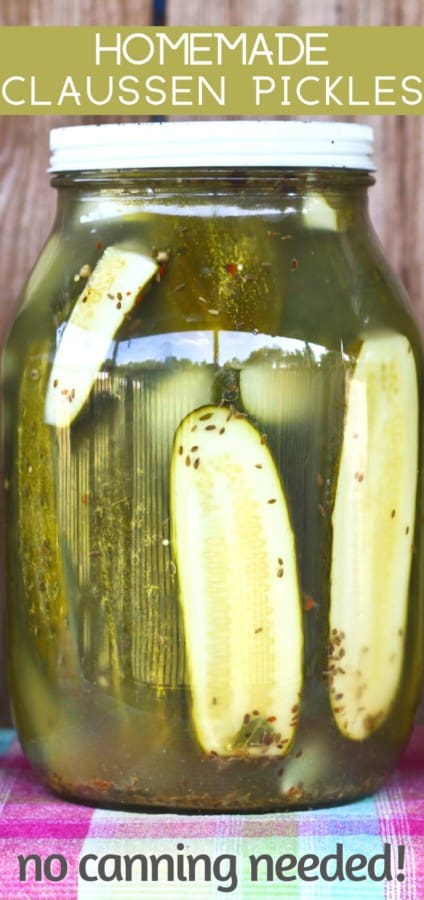
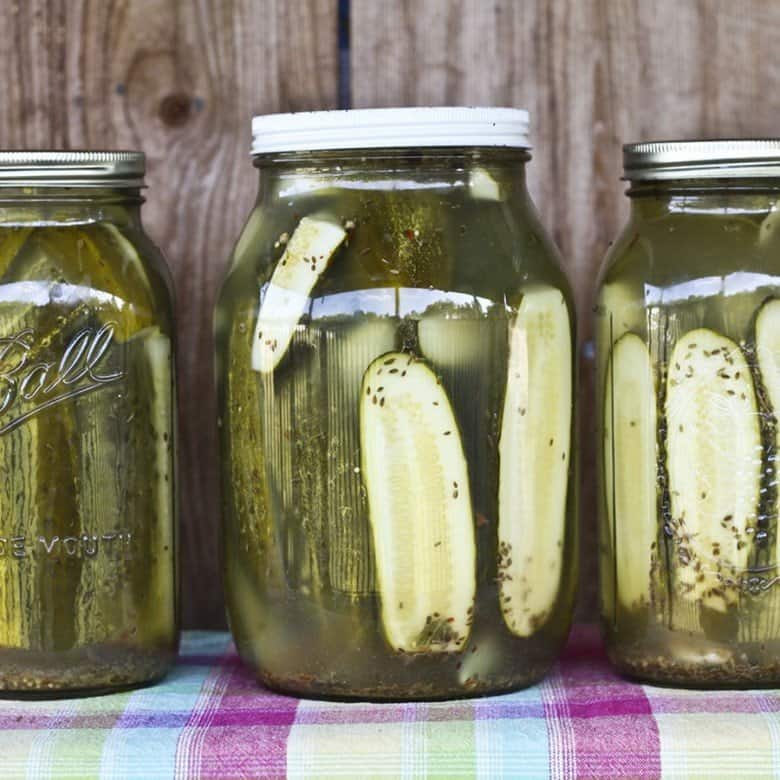
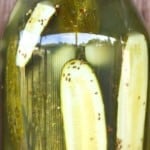



Reader's Thoughts...
Thomas McCort says
I don’t understand how you pour a gallon of brine into a one gallon container full of cucumbers.
Rebecca says
Hi Thomas! You don’t. The recipe actually says that you’ll have brine leftover. You will use more or less depending on the size and shape of your cukes and how many you fit in the jar. 🙂 Hang onto that brine and you can use it to top off the pickles as the brine evaporates.
Robert Mohr says
Will whole cucumbers work?
Rebecca says
You betcha; provided they’re small and fresh!
Mardi says
I have been combing stores for a Garlic pickle. I love Claussen refrigerated pickles so I plan on using your recipe, but have 2 questions. 1. Can I add as much garlic as I want to the recipe and 2. How do I make the brine less sour? I want the perfect balance of garlic, dill and salt, with the predominant flavor or characteristic of the pickle being garlic. Please recommend the number of garlic cloves to add to the recipe.
Rebecca says
Hi Mardi! Welcome! You can certainly add more garlic (I wouldn’t go higher than double the garlic in this particular recipe), but you definitely should not reduce the vinegar. If you’re looking for a less assertive tang, the apple cider vinegar should do the job. It’s a rounder tang than white vinegar (which is what’s used in Claussens) but it isn’t sweet.
Karen says
I have my grandmother’s antique pickle crock. Can I make these pickles in that crock then transfer to jars to refrigerate? I loved canning and make lots of canned pickles every year. Excited to try this recipe.
Rebecca says
Hi Karen- You sure can! Go for it and lucky you! Happy Pickling. 🙂
Bill says
Can pickles be refrigerated right away?
Rebecca says
You betcha, Bill! But you’ll probably have to wait a couple extra days for them to reach full deliciousness. 🙂
Julia Beall says
I made these Reich years ago and they were my family’s favorite! This year, I am having trouble finding fresh dill. What happens if I use dill weed instead?
Rebecca says
Hi Julia- Dill weed will work, too! It just has an ever so subtly less intense dill flavour.
Rebecca says
And thank you for taking the time to rate the recipe and let me know you love it, Julia!
Cathy Parr says
Can you freeze pickles? Could you freeze these clausen nock offs?
Rebecca says
Hi Cathy- I’m afraid that won’t work. The texture will be a little soft after freezing and thawing because the process will destroy the cell walls. 🙂
Anthony says
Claussen pickles do not have cider vinegar. This is not a claussen pickle recipe clone.
Rebecca says
Hi Anthony- Did you try the recipe before rating it? There are a great many things we can’t replicate in a home kitchen that are done in a commercial kitchen, but this home version of the recipe yields a pickle that tastes VERY much like a Claussen, hence the name. What it isn’t is a full replication of their process. I hope you decide to step out on faith and give it a go some time. You’ll probably be pleasantly surprised.
Danielle says
Claussen pickles use distilled white vinegar, it lists this as an ingredient on the jar.
Alyssa says
I just made these, and I’m curious what I did wrong. The taste was good but the middle of the halved pickle (where the seeds are) is super duper soft and mushy. I left on the counter a little over 48 hours since my cucumbers were quite large. My brine is also really cloudy? Help 🙁
Rebecca says
Hi Alyssa- Can you tell me what variety of cucumbers you used? Were they picklers? Or standard slicing cucumbers? It may be they were past their prime if they were very large picklers. Additionally, the bigger the cucumber, the larger the size disc you’ll need to slice from the blossom end to be sure you get that enzyme off that makes them turn mushy. The cloudy brine is no issue at all: it’s a natural by-product of fermentation and is a sign things are going well, actually.
I’d say if you know you had pickling cucumbers and they were dead fresh, you should probably consider two things: A) transferring them to the refrigerator at the 24 hour mark and letting them rest a couple days in the refrigerator until tasty or B) being careful to remove more of the blossom end of the cucumber.
Also, if they were slicing cucumbers, they would do exactly what you described above.
Annie says
The cucumbers could have had some hollow spots. This can affect the quality of the pickle. If you snap a cuke in half and see holes that is from lack of consistent watering while they were growing.
Rebecca says
You’re right, Annie! That’s another possibility for the pickles going soft or being “off”.
Kristi Whitman says
I made these last year. And qhile they were so delicious, were not crunchy at all. What would you suggest?
Rebecca says
Hi Kristi- There are a couple of things that may have happened, and without being in your kitchen, it’s impossible for me to know what’s going on, so I’ll just list a couple of possibilities for you and hopefully one will ring a bell!
1) It could be that your cucumbers were not super, duper fresh. I find that I get the best results from cucumbers that were either picked that day or well refrigerated for a day or two immediately after picking.
2) It may be that you did not manage to trim away the blossom end of the cucumber in order to remove that enzyme that causes softer pickles.
3) It could be an issue with the variety of cucumber that you used.
4) It might be that you waited a little too long before refrigerating them. I do taste test my pickles as they’re pickling and stash them in the refrigerator right when they’re tasty! Sometimes I even refrigerate them before they get to that point when my house is especially hot or humid.
Rebecca says
Oh! And if you want to take out a little crispiness insurance, you can always add a clean grape leaf or two to the bottom of the jar before adding your cucumbers and other ingredients!
Nicole says
It says cider vinegar but all I can find is Apple Cider or White Vinegar. What am I supposed to use?
Rebecca says
Hi Nicole- Cider vinegar is the same thing as Apple cider vinegar! Please use that. 🙂 In a pinch, you can use white vinegar, but it will be a lot sharper a brine.
Momo says
Hi, I am planning to try this recipe with my friends this Saturday. How many quart jars do I need for this recipe? Thanks.
Rebecca says
Hi Momo! You can probably fit these into 4 or 5 quart jars. 🙂
Karen Koper says
I’ve made fermented pickles for years. This recipe was really spot on as a Claussen knockoff.
Rebecca says
Thanks so much for taking the time to rate the recipe and let me know you love it, Karen! I truly appreciate it!
Judy says
Sorry, I had previously read on the reviews about what to do if the vinegar becomes cloudy the pickles are in.
I cannot find that answer do you mind replying one more time.
Rebecca says
Sure thing Judy! There’s no issue at all if the brine becomes cloudy. It’s still perfectly good and it’s a natural by-product of fermentation. 🙂
Linda says
Delicious. Have almost too many for my 2 refrigerators. Is it possible to freeze the Knock Off pickles??
Rebecca says
Hi Linda- I have not experimented with freezing the pickles, but my instinct is that it would not work very well. I’m afraid that it would make the pickles mushy when they thaw out.
Don Banks says
Sure would be nice to find one of these recipes that doesn’t use so many cucumbers. Many of us don’t have access to 35 or 40 cucumbers at one time. I bet very few do unless they go buy them, which defeats the purpose of looking for recipes. Why can’t someone make a small batch version? Search engines aren’t very honest these days
Rebecca says
Hey Don- Reduce the recipe by as much as you need to whether it’s 1/2, 1/4, or 1/8!! It honestly works great at about any quantity. I’ve been known to double or triple it, even! This is great for those of us who have abundant cucumbers in the garden! If you reduce the recipe and actually try it, I’d be honoured if you’d reconsider your 3-star rating. 🙂
Rebecca says
Additionally, you can have a “running batch” in your fridge, just shift the contents when you add new ones so the new cukes are at the bottom and the ones that are good for eating now are at the top. 🙂 When kept in the fridge constantly, it’ll take a little longer for the new ones to pickle, but they’ll get there.
Davey says
Don: I’ve never made the full-sized batch. I use maybe 10 cukes per batch. Just divide all the ingredients by 4 and you will be good to go. The water, vinegar and salt should be measured carefully. The garlic and seasonings are more forgiving and you can approximate the amounts to taste.
Janet says
What is the reason for keeping on counter for 2-3 days vs refrigerated right away?
Karen Koper says
Fermentation is much faster at room temp. It will still ferment in the fridge, but it will be much slower.
Trippn4re says
Hey Rebecca! Do you mind sharing what brand pickling spices you use? Or, are they generally the same set of spices from one brand to another? Thanks!
Rebecca says
Hi Trippn4re! I usually either use McCormick or a bulk seasoning I get from a local Amish bulk foods store! They’re pretty standard, but I do pick out the cloves and cinnamon bark when making these pickles. 🙂
Judy says
If I want to put in quart jars , how do I measure the spices & vinegar out for each quart? I like giving out my canning also to different people.
Gallon jar takes up some room in fridge & I can’t find a gallon glass jar at store.
Rebecca says
Hi Judy! Just divide the spices and cucumbers evenly between four quart jars. Then mix your brine as directed and pour over the contents of each jar. 🙂
Judy says
If I want to put in quart jars , how do I measure the spices & vinegar out for each quart?
Gallon jar takes up some room in fridge & I can’t find a gallon glass jar at store.
Karen Koper says
Walmart carries nice inexpensive Fido jars and Anchor Hocking “biscuit jars” that work great for fermentation.